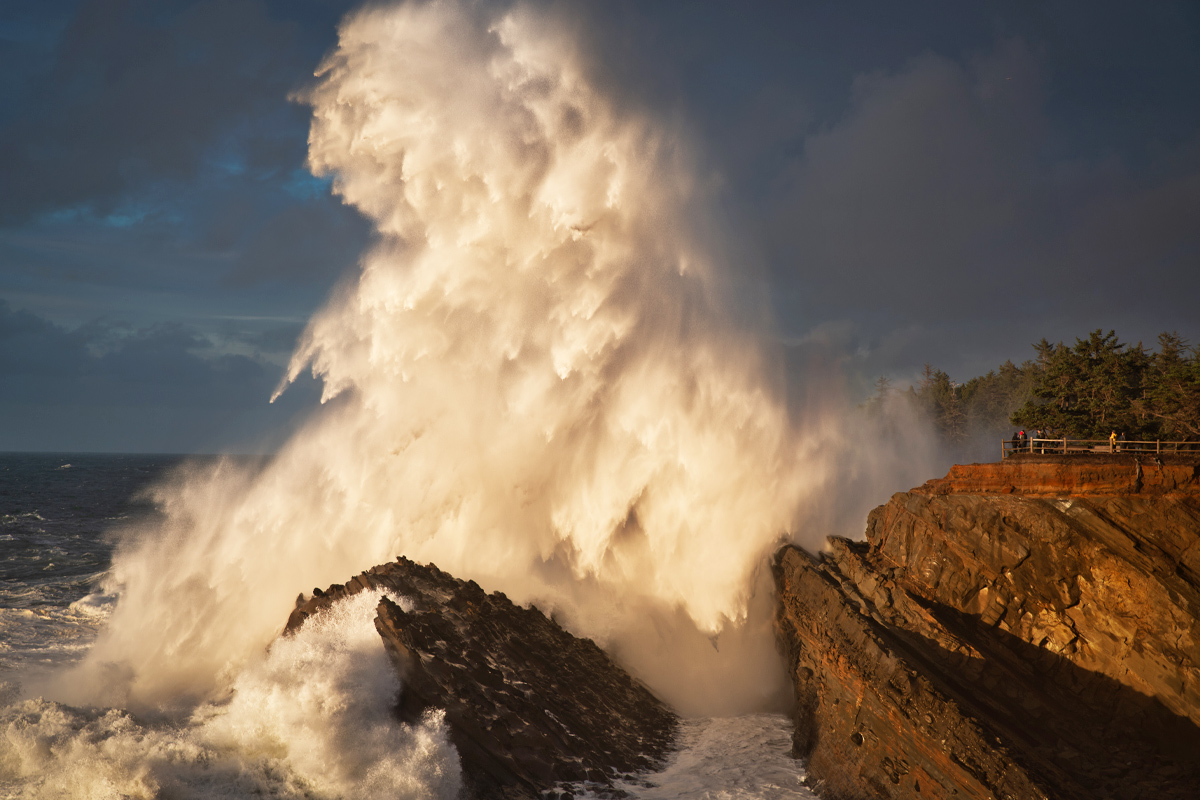Spy the remains of shipwrecks and stay safe while enjoying the beach.
For centuries mariners grappled with how to navigate channels up and down the Oregon Coast. The Columbia Bar, for instance, sits where the Columbia River empties into the Pacific Ocean — and has been the site of roughly 2,000 shipwrecks since 1792. Though nowadays things are much safer with jetties and bar pilots, the bar’s rough waters earned it the nickname “Graveyard of the Pacific.” Other passages have less dramatic but no less powerful stories of their own.
Today it’s possible to learn about the ghosts of Oregon’s maritime past at numerous shipwreck sites and museums along the Oregon Coast. And when our famously powerful winter winds and rains roll in — the same kind of weather that befuddled captains for centuries — several viewpoints offer safe opportunities for storm watching. Here are some great ways to see shipwrecks and winter storms on the Oregon Coast.

Experience Historic Lighthouses and Jetties
With rough waters and dangerous crossings, life at sea was treacherous, but by the late 1800s, technology — in the form of light and breakwaters — changed the face of shipping on the Oregon Coast.
In 1857 the Umpqua River Lighthouse became the first lighthouse on the Oregon Coast, throwing its powerful beam across the waters from its home south of Winchester Bay. Eventually, more than a dozen lighthouses would light the way for ship captains along much of the Oregon Coast. Many have been decommissioned, but several — including Yaquina Head Lighthouse near Newport and Heceta Head Lighthouse near Florence — remain popular destinations today.
By the late 1800s, engineers had figured out another way to harness nature’s power. On the Oregon Coast, jetties were constructed from rocks and boulders at waterway entrances to create more stable channels and direct the flow of water into the Pacific Ocean. Today you can see jetties in action at a number of Oregon beaches and bays, but it’s important to stay off the often-slippery rocks in case of heavy surf or rogue waves that occur even when the sea is relatively calm.

See Shipwrecks and Learn More at Museums
In 1846 the U.S. Navy’s USS Shark broke apart in the Columbia Bar, and the nearby community of Cannon Beach was eventually named for the ship’s artillery — some of which washed ashore. You won’t see the shipwreck itself today, but its cast-iron carronade is on display at the Cannon Beach History Center & Museum. For more on the Columbia Bar’s history with shipwrecks, spend a few hours perusing a detailed shipwreck exhibit at the Columbia River Maritime Museum in nearby Astoria.
Sixty years later, the British ship Peter Iredale ran aground just south of the bar — and the rust-covered remains of its steel hull are today one of the most popular sites on the entire Oregon Coast. Walk up to the shipwreck on the shoreline at Fort Stevens State Park. And occasionally, when the sands have blown away and the tides are right, you can see the skeletal wreck of the Emily G. Reed, which came aground in 1908 at Rockaway Beach. If you’re in Depoe Bay at very low tides, look for the massive rusty boiler of the J. Marhoffer — which sank nearby in 1910 — from the basalt-lined Boiler Bay State Scenic Viewpoint.

Have Fun and Stay Safe Watching Storms
These days a mix of technology, jetties and bar pilots have helped make shipwrecks exceedingly rare. If you’d like to safely see some of the weather that has historically made life difficult for mariners, storm watching is a popular winter pastime on the Oregon Coast.
While you’re visiting, watch for King Tides, ultra-high tides that flood the beaches and create dangerous conditions. They occur this winter on November 15-17, 2024, December 13-15, 2024 and January 11-13, 2025. Use special care during this time. Learn more — including how to help scientists track these massive tidal occurrences — at the Oregon King Tides project.
One dramatic viewpoint can be found at Shore Acres State Park near Coos Bay. There a small, enclosed structure sits protected from the elements and offers wide-open views of the surrounding surf from atop a sandstone cliff.
Farther north, Ecola State Park sits on Tillamook Head just north of Cannon Beach. Its wheelchair-accessible Ecola Point Day-Use Area resides high above the surf and offers wide-open views of winter weather punishing the rock formations below.
Wherever you go in winter, you’ll want to keep a few tips in mind for staying safe.
- Wear warm layers of clothing, topping them off with one made with waterproof materials, to protect against the elements.
- Keep a safe distance from the waves, preferably where the ocean won’t touch you, and always stay off jetties.
- For any beach excursion, be sure to look up local tide tables so you can plan for the conditions.
- Always remain mindful of sneaker waves, stay off logs that might have washed ashore and never turn your back on the ocean.
- Learn more about storm-watching safety on the Oregon Coast.
– By Matt Wastradowski
Top photo by Jeremy Burke
in Attractions, Seasons